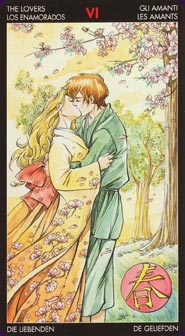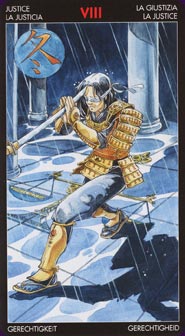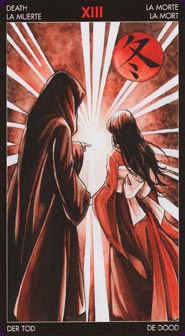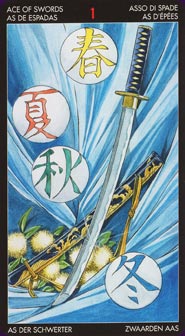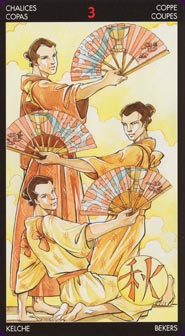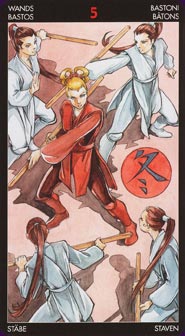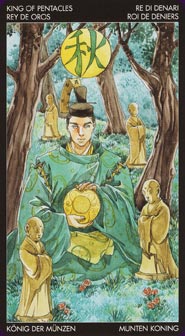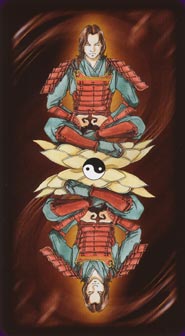Manga Tarot Deck Review
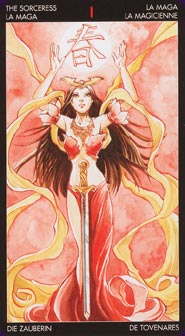
This Manga Tarot is a a deck connected with the Eastern imagination, as illustrated in the comics known as manga. It has attractive artwork which is in the manga/anime style (but not exaggeratedly so), and the symbolism is fairly recognisable. There is one significant change however - cards that traditionally showed a man now show a woman, and vice versa.
Deck Type: Tarot Deck Cards: 78
Creators: Riccardo Minetti, Anna Lazzarini
Publisher: Lo Scarabeo 2006
Retailers
See Price at Amazon.comSee Price at Amazon.co.uk
See Price at Amazon.ca
Manga Tarot Review by Kate Hill
“This Tarot is connected with the fantastic oriental imagination, particularly Japanese, as depicted in the artwork of the comics of the Land of the Rising Sun, called Manga.”
The Manga Tarot is the brainchild of Riccardo Minetti at Lo Scarabeo, who came up with the Etruscan Tarot, Fey Tarot, and Gothic Tarot of the Vampires, and new Tarot artist Anna Lazzarini, who is well known in the world of Italian comics.
The basic foundation of the cards is the imagery of the Rider-Waite, but the symbolism and concepts are more individual and have been interpreted in an Eastern manga/anime style. It’s a very human deck, with people on every card and a close-up feeling of involvement in the scenes, all surrounded by relatively unobtrusive black borders.
The traditional Tarot iconography has been inverted throughout the deck, so that cards that would have shown men now show women and vice versa. Some of majors have also been reordered to fit the gender changes:
0 – The Fool – Space
I – The Sorceress – Will
II – The Priest – Spirituality
III – The Emperor – Protection
IV – The Empress – Nourishment
V – The Priestess – Knowledge
VII – The Chariot – A Victory
VIII – Justice – Equity
IX – The Hermit – Meditation
X – The Wheel – Time that passes.
XI – Strength – Energy
XII – The Hanged Woman – Equilibrium
XIII – Death – The Threshold
XIV – Temperance – Purification
XV – The Devil – The dark side.
XVI – The Tower – Ashes
XVII – The Stars – Hope
XVIII – The Moon – Harmony
XIX – The Sun – Truth
XX – Judgement – The End
XXI – The World – Soul
I particularly like the Emperor/Empress pair in this deck. The Empress is a resolute mother wearing armour and shield, ready to protect any that threaten her brood, her creations. The Emperor, rather than being on a throne is seated on the floor, meditating, and has a sense of hidden power that is only used discriminately. (He also appears on the backs of the cards, mirrored in a reversible design on a black background.)
The minor arcana are divided into four typical suits of Wands, Swords, Chalices and Pentacles. The cards of each suit share a dominant colour that corresponds to the card’s internal theme – air/intellect, earth/nature, fire/personality, water/feelings - and also have a circular ’glyph’.
These glyphs are Japanese characters for the seasons, and indicate the timing and cyclical nature of the cards: spring as birth or beginning, summer as growth or maturity, autumn as decline or old age, and winter as death or minimum. Most but not all cards follow this structure - the Fool is outside of it with no glyphs; the Wheel has all four; Aces have all four; the Tens are missing one each of the seasonal glyphs; plus the World is the sum of all four seasons, so it has no dominant colour.
The court cards in this deck have been altered and reorderd to make the relationships between mother, father, daughter and son more obvious, and were also retitled to Prince, Princess, King and Queen. Princesses, in this deck, are the ones with the steeds – a horse, a whale, a dragon and a tiger.
Throughout the deck, there are also shifts in the imagery of some cards to bring a different facet of meaning to the fore. The Fool is the most obvious example, being a bleaker card in interpretation and colouring; a girl, wearing torn clothing, walks towards the cliff edge with her hand over her face. Of others, the Seven of Pentacles shows a woman admiring a jewel on her wrist, with more at her feet, with the written meaning of having and enjoying things. A man walks through the snow in the Eight of Chalices, interpreted as the need to admit mistakes.
The booklet first explains the deck structure, the colour system and the glyphs, and offers insight into the altered imagery and the concept in each card. The back of the booklet has information on using the Tarot, how to study the deck, and a six card relationship spread. In between are the meanings, the phrases and aphorisms unique to the cards in this deck. For example:
0 – The Fool – Space. A young woman dressed in clothes once lavish, now torn, moves closer to the edge a ravine. Flowers sprout where she walks. It is a the nature of things that space desires to be filled.
XV – The Devil. The dark side. Rage, violent or uncontrollable passions. Slaves of one’s own drives of fears. Inability to look inward. Meanness to others. No one is perfect.
3 of Chalices – Celebration. Cheerfulness, dance, energy, celebration. Temporary happiness. The harmony of dance is sharing.
Artistically, the Manga Tarot has attractive images and season symbols that are more decorative than distracting. It’s also not as ‘anime’ looking as one might think, having a more realistic illustrated style (except where children are illustrated). It does diverge from the traditional enough to be more difficult for a beginner, but has new ideas, interpretations and perspectives to offer a more experienced Tarot reader.
Manga Tarot Review by Gavin Pugh
This Tarot is connected with the fantastic oriental imagination, particularly Japanese, as depicted in the artworld of the comics of the Land of the Rising Sun, called Manga.’ from the little white book.
The Manga tarot takes the unusual approach of focusing on the feminine aspects of tarot. In the Majors the positions that are traditionally male are female and vice versa. We start with a female Fool, The Magician is The Sorceress, The High Priestess becomes The Priest and so on, and even the court cards are renamed and reordered to become Prince, Princess, King and Queen. The little white book (LWB) describes the changes in the court cards as… ‘making the internal relationships of the Court cards more obvious and intuitive: mother, father, daughter, son.’
Even though this change is unusual it doesn’t feel unnatural. Now this change might upset traditionalists and if you’re one of them this might not be the one for you. But for those who love to explore different aspects of the tarot it is certainly stimulating.
There are no astrological symbols on these cards instead each card has a dominant colour and a glyph. The dominate colour corresponds to the suit and its aspect of the cards ‘internal theme’. The Glyphs represents the qualities of a season. The way both the dominant colour and glyph are filtered the meaning of the cards adds another way of getting you to think about the card.
For example Justice(Keyword: Equity) has a glyph of Winter, which means death, minimum, night, silence. I interpret Winter when filtered through Justice to suggest that the can be no emotions allowed and Justice is a lonely and barren business.
Another example is the Three of Wands with the keyword Wait and the glyph of Summer: growth culmination, noon, maturity. This is strangely at odd and yet not. The meaning usually of the Three of Wands for me is growth and two things coming together to make a third, but this does take time so wait and summer fits.
It might just be me but the glyph on each card that represents each season seemed at first hard to figure out. But it does make sense in the end.
The idea of a dominant colour is great as it gives an instant visual summery of the mood of a reading and where areas of focus maybe. One card that doesn’t have any dominant colour is The Fool and this therefore gray. I would have preferred to have The Fool bright and all colours but this is minor.
Even with the new correspondences those who are familiar with the Waite-Smith model should have no problems adjusting to this deck . Cards such as the 8 of Cups, 6 of Swords, 6 of Wands are variations of the images in the Waite-Smith. Though with , the swap of males and female these images still manage to feel fresh and interesting.
The art of Anna Lazzarini is lovely, though the colour tones and images at times border on cute but, for me, Manga always does have a cute quality. There is a little nudity, a couple of bare male chests, and the Hanged Woman is nude – you see her back from a distance, but none of the imagery is offensive or graphic. I feel that the look of the deck will appeal to a large audience.
This will definitely appeal more to woman than men mainly due to the swap of male and female places. As I’ve said this makes it refreshing. All tarot cards have male and female aspects and altering the balance makes me see the cards in the Manga Tarot in a new light.
The little white book (LWB) is, with almost all Lo Scarabeo LWB., in five languages. Though what is different about this one is that it is presented in a landscape format but I’m not sure if this actually gives any more text for space. There is enough detail included about the system and the cards themselves to initiate you into the deck. As with all Lo Scarabeo LWB the pleasure of this deck would be enhanced by a more detailed text. I’d love to see more descriptions of the images and maybe how the choice of glyph come through in the meaning of the deck itself.
In readings I’ve found this deck spot on, and I haven’t had any moments of miscommunication or where I’ve been struggling to make a connection or association.
Overall there is a lot to study and explore in this deck. And not only is it good to read with it is visually stunning. I whole hearted recommend it to collectors, art lovers, and those who want a deck with a bit of depth.
Manga Tarot Review by Bonnie Cehovet
My first impression - this is an absolutely stunning deck! I am strongly attracted to the Oriental culture, which is the culture reflected in this deck. The deck was named after the comics of the Land of the Rising Sun (Japan). It is a traditional, 78 card deck. The Major Arcana retain their original structure (Justice VIII, Strength XI), with some of the cards having been renamed, and with male/female roles reversed:
Fool
The Sorceress (The High Priestess)
The Priest (The Magician)
The Emperor (The Empress)
The Empress (The Emperor)
The Priestess (The Hierophant)
The Lovers
The Chariot
Justice
The Hermit
The Wheel (The Wheel of Fortune)
Strength
The Hanged Woman (The Hanged Man)
Death
Temperance
The Devil
The Tower
The Stars (The Star)
The Moon
The Sun
Judgment
The World
The suits are Wands, Chalices (Cups), Swords and Pentacles. The Court Cards are King, Queen, Princess and Prince. Each suit is based on two structural characteristics: (1) a dominant color, and (2) a glyph. The dominant color indicates the suit Element as well as an aspect of human nature. Each glyph indicates a season (Spring, Summer, Autumn, Winter), with the four seasons referring to the temporal and cyclic element of the card. From the LWB (Little White Book):
"Red: Wands, Fire, Personality Yellow: Chalices, Water, Feeling Blue: Swords, Air, Intellect Green: Pentacles, Earth, nature"
The Fool does not have a dominant color or glyph, because it cannot be forced into a structure. The Wheel, representing cycles, contains all four glyphs. The World does not have a dominant color because, in its completeness, it contains all four of the elements. The Aces contain all four of the seasons because they each contain within themselves the potential for the entire journey. The Tens contain three glyphs - in his commentary, Minetti notes that the missing glyph should be considered before attention is paid to the three existing glyphs.
Due to the fact that the roles of the figures in this deck are reversed from the traditional roles (males become females, females become males), the Court Cards are modified so that the Queen changes places with the King, the Knight becomes the Princess, and the Knave becomes the Prince. The representation then becomes: mother, father, daughter, son.
There are no scans in the LWB. The cards are presented by number, title, keyword, and description. From the LWB:
"III - The Emperor - Protection. Control, strength, responsibility. Provide for others, watch over them, protect them. The right to rule does not derive from force but rather humility."
"Wands - 4 - The moment. Celebration, cheerfulness, the present, fleeting, instant. Here and now, fully present."
"Queen of Pentacles - Harmony with the environment. Harmony between us and the world that surrounds us is the basis of happiness."
The instructions in the LWB are translated into English, Italian, Spanish, French and German. The spread presented uses six cards, with the following position definitions: (1) the relationship at its beginning, (2) the relationship now, (3) how the relationship will develop, (4) the things that attract you to each other, (5) the things that repel you from one another and (6) the surrounding world.
The cards themselves are 2 1/2" by 4 3/4", of good quality, glossy card stock. the back of the cards show a dark background, with a back to back image of the Emperor - a figure seated on a golden lotus, in a meditative position. The yin/yang symbol is superimposed between the two lotuses.
The card faces show a dark border, surrounding the illustration. Translations for the card title for the Major Arcana are placed in the four corners, in white lettering, in English, Italian, French, German, Spanish and a language that I do not recognize. The card number is placed in red in the center of the card. The Pips (numbered cards) show the suit translated in each of the four corners, in white lettering, with the card number centered on top of the card in red. The Court Cards show the rank and suit translated, in white lettering, in each of the four corners.
The artwork is a combination of reality and fantasy, done in muted colors of red, yellow, green, blue, gray, brown and a brownish red. Were there room in a review, I would talk about all of the cards - they are that good! However, I do have to pick and choose. The first card that I want to mention is the Fool. There is no color in this card, as the Fool is at the beginning of her journey. The figure is female, and walks gently to the edge of the precipice, a white dog walking at her side. The Sorceress is stunning - showing a figure standing with both arms raised, yellow ribbons surrounding her, with a muted red background.
The Lovers is one of the best versions of this card that I have ever seen, showing a young couple embracing, with a forest in the background. The Hermit is an older, Wise Woman, with fractals of white light bouncing around the card. The Wheel shows an Oriental couple kneeling, facing each other, in front of a wheel which is broken into four quadrants, reflecting all four glyphs and the cycles of the four seasons.
The Hanged Woman is suspended as she goes over a waterfall, head first/. The Moon shows a female figure dancing under a crescent moon with a large white bear, with white swans at their feet. Very shamanistic! the Three of Chalices is certainly different, showing three male figures, in kimonos, holding open fans. The Seven of Chalices shows seven inverted chalices, with a young figure facing a dragon, who is facing him. The dragon's feet are on an open scroll.
The Four of Pentacles shows a solitary female figure, kneeling in front of a brick wall, with one pentacle in her right hand, and three more on the floor in front of her. High up in the wall is a window with four quadrants, showing living, vibrant tree limbs with green leaves.
The thought behind this deck, in the interpretation and presentation, as well as the artwork, is amazing. I have not been this impressed since Ciro Marchetti's Tarot of Dreams. A unique deck for reading, meditation, journeying, ritual and ceremonial work. A fine addition to any Tarot collection, and a deck that can be used by all levels of Tarot students.
© Bonnie Cehovet
Manga Tarot Review by Kim Huggens
Although there are many decks that I review positively (especially recently when there have been a number of excellent decks printed), few cause me to rave about them. Few take my breath away and make me want to read with them instantly. Having studied Tarot for a number of years, my usual criteria for a deck’s worth to me is how deep, symbolic, and filled with esoteric and occult imagery it is. If it’s complex and needs some serious time and effort to understand, then it’s a deck for me!
So when a simple, evocative, and utterly symbolic deck without all that complex esoterica attached to it comes along, I naturally gear myself up for disappointment. Not so with the Manga Tarot, an upcoming release from Lo Scarabeo. Created through a collaboration between Riccardo Minetti (author of the popular Fey Tarot and Vampire Tarot) and Manga comic artist Anna Lazzarini, this deck is exactly what its’ title suggests: a Tarot deck illustrated in the world and style of Manga.
The article on Manga at Wikipedia.com says that the way Manga is drawn (few lines, exaggerated facial features) makes the image a projection of an idea rather than physical reality. This is so close to Tarot imagery that the two seem to fit well together: Tarot’s pictures also are symbolic projections of ideas and aspects of the universe and life, rather than a portrayal of them in reality. Death, for instance, is not physically a skeleton with a scythe on a white horse – it may symbolically be so, and thus Tarot depicts projections of an idea just as Manga does.
The Manga Tarot does not present itself in a comic-book style however (which is a good thing in my opinion), and also does not use all the characteristics of Manga style (again, probably a good thing.) Instead, it is a very elegant deck with each card image portraying a scene that you can imagine occurring in a comic book yet at the same time in real life: surrounded by cherry blossom trees and a slight breeze, The Lovers embrace and are lost in themselves. Her white kimono torn and ragged, The Fool walks with her hands over her eyes towards a cliff-edge, flowers trailing behind in the wake of her footsteps. On a slippery marble floor in the rain, a blindfolded and armoured man carefully balances a sword between his palms, its point at his forehead, and walks forwards in Justice. No complex occult symbolism is needed in these striking images to understand the meaning they are trying to convey.
Every single card of the Major Arcana is beautiful and elegant, every now and then retaining a traditional symbol from the Rider Waite Tarot (such as the white dog in The Fool, and the book in The Priestess). Yet the images are sometimes very different from traditional Rider Waite decks. In this deck, for instance, Death is no longer a skeleton on a white horse, but a cloaked and hooded figure taking a young woman by the hand and leading her towards a bright light. Despite the differences in imagery, it is still very easy to tell which card is which – again, because they are so evocative and meaningful without any occult symbolism.
In places card titles have been changed, usually to better fit an interesting feature of this deck: where there are traditionally men in the cards, the Manga Tarot has women. Where there are traditionally women in the cards, the Manga Tarot has men. This can get a little confusing when it comes to the Empress, Emperor, Priest, and Priestess, since II is now The Priest (while retaining the meanings of The High Priestess) and V is now The Priestess (while retaining the meanings of The High Priest.) Similarly, the Empress and Emperor’s titles have swapped places, but The Emperor retains the meanings of The Empress and vice versa. Whilst many may argue that this takes away an important symbol of the Tarot (e.g. masculine = active, aggressive, assertive, feminine = passive, receptive, intuitive) I think that it makes a more experienced Tarot reader look more than once at the images and think about them. It is easy for experienced Tarot readers to get into habits with the cards, sometimes taking things for granted that they maybe shouldn’t. A deck like the Manga Tarot opens their eyes and invites them to continue their studies with a ‘beginner’s mind’ once more. And luckily this change does not make the deck difficult to read for beginners: the imagery is so meaningful and easy to understand that somebody without any experience of Tarot could easily read with this deck by just asking themselves what is going on in the cards.
Everything I have said about the Major Arcana can be applied also to the Minors. They are equally as beautiful and elegant, and because this deck has no occult or esoteric symbolism attached to it they are just as meaningful. If you took away the borders of the deck, an untrained eye would not be able to tell the Minors apart from the Majors – and that, to me, is a great thing. I dislike putting the cards into categories of “little secrets” and “big secrets”, believing that every card in the deck, Major, Minor, and Court alike can denote both complex archetypes and mundane realities. The Manga Tarot really conveys this idea, since it is obvious that Lazzarini has spent as much time and energy on the Minors as she has on the Majors. Hurrah! And once again, the Manga Tarot moves away from traditional Tarot imagery, giving us some food for thought and interesting ways of seeing the cards. One that I particularly like is the Five of Pentacles: a couple prays before a shrine in the snow, their heads and knees bowed in prayer, while incense burns. They ask their ancestors or Gods for the help they so desperately need. In the Six of Pentacles we no longer have a somewhat smug-looking benefactor handing out money to begging hands: instead, a tall, beautiful woman takes off her silk glove to place a hand on the cheek of a leper. As she comforts the man with her touch, tears fall down her face. Hell, I know that tears fell down my face when I saw that card.
I find the way the suit symbols are represented in the Minor Arcana to be an ingenious way of showing which suit the card is from, whilst not taking over the image with a bunch of cups or swords. In the Seven of Pentacles the Pentacles are found on a necklace whilst in the Six they appear to be golden flowers opening. In the Three of Cups we find the cups painted on the fans of three male dancers and in the Nine of Swords the swords are wielded by nine demonic figures who terrorize a man in bed. Great stuff. The Court Cards are also colourful, evocative, and elegant, though the gender of the figures have also been swapped round, changing the order of Princess (Page), Prince (Knight), Queen, King to Prince, Princess, King, Queen. As with the swapped Major Arcana though, despite the card title the meanings remain the same. The meaning is conveyed wonderfully in these cards: in the facial expressions of the figures, what they are doing, their surroundings, and more.
One very useful feature of the deck is the use of colour and ‘glyphs’ within each card. The accompanying little white book says that each card has a dominant colour and glyph, the colour “…indicates a suit of the Minor Arcana and an aspect of human nature, of the surrounding world, or the how, “with what eyes” we view others, ourselves and things. It therefore represents a card’s internal theme.” This means that even the Major Arcana are linked to the Minors through colour – and some Majors have no dominant colour at all (indicated by white, found in The Fool, or many colours, found in The World. This is explained in the little white book.) This use of colour also allows beginners to get some idea of the nature of each card based on the colour (since the book gives a brief summary of what the four dominant colours mean), allowing them to read the cards easily and quickly. The glyphs represent the four seasons, and appear on every card except The Fool. They indicate cyclic and temporal aspects of the cards, such as birth, endings, growth, minimum, and decline. This would be interesting to study further to find the links between cards.
The backs of the cards are reversible and beautiful, showing the figure from The Emperor, meditating on a lotus. The accompanying book (63 pages in total, though only 12 of those are in English, the rest being devoted to Italian, Spanish, French, and German) whilst being small is still very useful, demonstrating some really good and original approaches to the cards that would be excellent for beginners. Each card meaning is accompanied by a phrase that sums up its deeper meaning: “Nothing is forever and every moment has its worth” for the Wheel of Fortune, “Thoughts come from the heart and take on life” for the Prince of Cups, and “The mind must become a blank page at the beginning of each chapter” for the Four of Cups. As well as being useful summaries for a beginner, I think an experienced Tarot reader could gain a lot of insight by meditating on these phrases.
Overall, the Manga Tarot is an utterly beautiful, elegant, friendly, easy to read deck. Its simplicity contains its depth, and every card shines with an intensity that can instantly be connected to. Highly, highly recommended. My hat goes off to Minetti and Lazzarini for a wonderful addition to the Tarot world.
Complete Details of Manga Tarot
Creators: Riccardo Minetti, Anna LazzariniPublisher: Lo Scarabeo 2006
Deck Type: Tarot Deck
Cards: 78
Major Arcana: 22
Minor Arcana: 56
Deck Tradition: Rider-Waite-Smith
Minor Arcana Style: Unique Scenes With Suit Symbols
Suits: Chalices, Swords, Wands, Pentacles
Court Cards: Prince, Princess, Queen, King
Major Titles: The Fool, The Sorceress, The Priest, The Emperor, The Empress, The Priestess, The Lovers, The Chariot, Justice, The Hermit, The Wheel, Strength, The Hanged Woman, Death, Temperance, The Devil, The Tower, The Stars, The Moon, The Sun, Judgement, The World
The Fool is 0
Strength is 11
Justice is 8
Card Size: 2.60 x 4.72 in. = 6.60cm x 12.00cm
Card Language: Spanish, Italian, German, French, English, Dutch
Card Back: Reversible
Back Design: Mirrored image of the Emperor.
Companion Material: 64-page wide format booklet in English, Italian, Spanish, French and German.
Rating: 18/20 or
Similar Decks to Manga Tarot
Theme: Anime, Eastern, MangaCreator: Epic Tarot, Etruscan Tarot, Fey Tarot, Gothic Tarot of Vampires, Manga Tarot Mini, Tarot of the Journey to the Orient by Riccardo Minetti Lo Scarabeo Tarot, Manga Tarot Mini by Anna Lazzarini
< Previous Deck · Back to Top · Next Deck >
Home > Tarot Reviews > Manga Tarot Review

